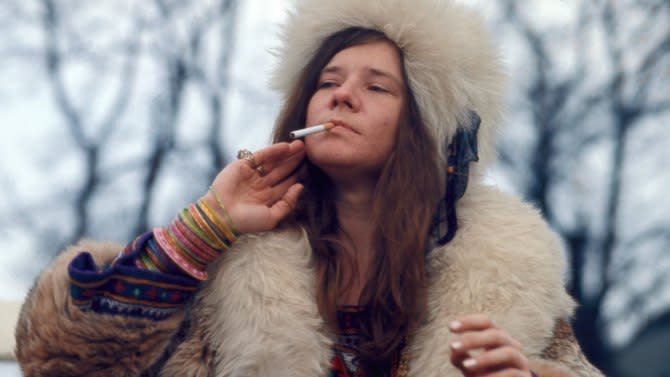'Janis Joplin: Little Girl Blue' Breaks Down A Rock Legend

Janis: Little Girl Blue, airing Tuesday night on PBS’ American Masters, does a good job of depicting why Janis Joplin was so appealing a figure in 1960s rock. It also demonstrates the problems of making a documentary at the behest of a family estate that wants its own version of Joplin’s life to become the accepted one.
Joplin emerged from Port Arthur, Texas in the 1960s with a big voice and a head full of the blues — both blues music from black musicians she idolized, and a blue mood from the ridicule she endured at school as an outsider whose interests and appearance didn’t match the very conventional norms. Moving to San Francisco, she joined forces with Big Brother and the Holding Company, not the most precise but certainly a spirited band, and gained rapid attention for her deceptively wild howling, a vocal style over which she always maintained more control than she was given credit for.
Director Amy Berg, given access to the Joplin family estate’s collection of Janis’s correspondence, photographs, home movies, and archival footage, chronicles these early years well. (Some of the letters and narration are read by Joplin fan Chan Marshall — a.k.a. Cat Power.) Lots of talking heads try to summarize Joplin’s sound and originality, but none succeed as vividly and concisely as Lillian Roxon did in her Rock Encyclopedia published in 1969: “People had to readjust their thinking because of her. Her voice, for instance. Chicks are not supposed to sing that way, all hoarse and insistent and foot-stamping. They’re not supposed to sound as if they’re shrieking for delivery from some terrible, urgent, but not entirely unpleasant, physical pain… Janis has redefined the whole concept of the female vocalist.”
The film cannot understate Joplin’s early humiliations as a source of her drive and ambition. To cite just one example: She was voted “Ugliest Man on Campus” in a fraternity-hour newspaper when she attended the University of Texas in Austin. Unfortunately, Little Girl Blue does understates Joplin’s homosexuality and bisexuality; these key elements in her life and, by extension, her art are relegated to an interview with a single girlfriend, Jae Whitaker, and, even more briefly, references to long-time “friend and lover” Peggy Caserta. Caserta’s presence is obscured by far more anecdotes about and from boyfriends, particularly David Niehaus, who’s portrayed as Joplin’s heart-breaker. It seems obvious that references in the film to the “difficulties” Joplin’s lifestyle presented to her apparently straitlaced family must have influenced these directorial emphases. (Current Joplin scholarship is divided between those who champion two Joplin biographers, Myra Friedman, whose bestselling 1973 bio Buried Alive is the one I grew up with, and Alice Echols’ 2000 book Scars of Sweet Paradise: The Life and Times of Janis Joplin, which places more emphasis on her subject’s relationships with women than either Buried or Little Girl Blue.)
Overriding much of this, including the music, is Joplin’s substance abuse. As Little Girl Blue makes clear, the initial image of Joplin as a boozy blues-mama swigging from a bottle of Southern Comfort eventually devolved to Joplin the isolated heroin-shooter. It’s a sad tale, of course, culminating in her 1970 death at age 27 — that doomed death-age that has also claimed Jimi Hendrix, Jim Morrison, Amy Winehouse, and others.
Today, Joplin’s best-known music (her a capella “Mercedes Benz”; her cover of Kris Kristofferson’s “Me and Bobby McGee”) remains fixed in its time — her beloved blues and the grittiest kind of 1960s soul music are not the genres that contemporary young listeners are likely to latch onto. She was rarely backed by bands with talents as great as she had, and she recorded relatively little music, her reputation burnished primarily by live performances. Combine all this with Joplin’s disinclination to encourage the sort of rock-star mystique that built up so easily around Hendrix and Morrison — Joplin was always more inclined to be either prosaically honest in interviews, or frustratingly circumspect — and Little Girl Blue is more like a time capsule of a bygone era than the showcase for an enduringly vital artist.
Janis: Little Girl Blue airs Tuesday night on PBS. Check your local listings for times.


